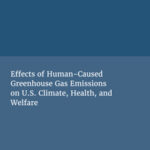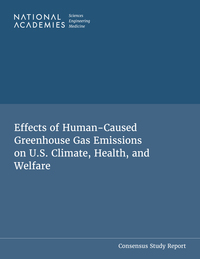
The expedited update of the 2009 EPA hazard finding from the National Academies of Sciences, Engineering, and Medicine (NASEM) has now been released.
Unsurprisingly, they have come out strongly in favor of strengthening the conclusions of the 2009 finding. Specifically, they conclude that:
- Greenhouse gas (GHG) emissions from human activities are increasing the concentration of these gases in the atmosphere. … Multiple lines of evidence show that greenhouse gas emissions from human activities are the main driver of the observed long-term warming trend. No known natural factors, such as incoming solar radiation or volcanic emissions, can explain the observed changes.
- The improved observations unequivocally confirm that greenhouse gas emissions are warming the Earth’s surface and changing the Earth’s climate. Longer records, improved and more robust observation networks, and analytical and methodological advances have strengthened the detection of observed changes and their attribution to elevated greenhouse gas levels. Observed trends include increases in warm extremes and single-day extreme precipitation events, decreases in cold extremes, regional changes in annual precipitation, warming of the Earth’s oceans, a decrease in ocean pH, sea level rise, and an increase in the severity of wildfires.
- Human-caused greenhouse gas emissions and resulting climate change harm the health of people in the United States. Climate change intensifies risks to humans from exposure to extreme heat, ground-level ozone, airborne particles, extreme weather events, and airborne allergens, affecting the incidence of cardiovascular, respiratory, and other diseases. Climate change has increased exposure to pollutants from wildfire smoke and dust, which has been linked to adverse health effects. The increasing severity of some extreme events has contributed to injuries, illnesses and deaths in affected communities. Health impacts related to climate-sensitive infectious diseases, such as those transmitted by insects and contaminated water, have increased. …While non-climate factors, including adaptation measures, can help people cope with the harmful impacts of climate change, they cannot eliminate the risk of harm.
- Changes in climate resulting from human-caused greenhouse gas emissions harm the well-being of people in the United States. Climate changes in temperature and precipitation extremes and variability are causing negative impacts on agricultural crops and livestock, even as technological and other changes have increased agricultural production. Climate change, including increased climate variability and wildfires, is changing the composition and function of forest and grassland ecosystems. Climate-related changes in water availability and quality vary among regions of the United States, with some regions showing a decline. Climate-related changes in ocean chemistry and heat content are having negative effects on calcifying organisms and contributing to increased harmful algal blooms. …
- Continued greenhouse gas emissions from human activities will lead to further climate change in the United States, and the severity of the expected change will increase with each ton of greenhouse gases emitted. …
It is worth stopping to understand why this is not surprising. This is because the evidence of change, of the attribution of that change, of model skill, of impacts and, yes, of damage, is enormously greater than in 2009. Fifteen additional years of observations both in situ and from satellites. In 2009, Terra/Aqua/Aura had only been watching for a few years. The GRACE records of ice mass loss, ocean mass rise, and groundwater depletion lasted only a few years. Now more than two decades have passed. The Argo floats had only just begun to spread enough to reduce the error in estimates of ocean heat content. Key papers on the attribution of individual events only began to appear in 2011. The climate model projections available in 2009 came from the CMIP3 ensemble, a group of models that, impressively, continue to successfully predict global mean temperatures, but are significantly less skillful compared to the current models (CMIP6, or better yet, the models being prepared from CMIP7).
2009 was before Harvey, Ida, Florence, Sandy, Irene, events that, while not “caused” by climate change, had impacts on the US (through rainfall amount, intensity, and storm surge) that were most likely intensified by it.
Instead of the situation being more uncertain than in 2009, we are much more confident in the fundamentals than before, and where uncertainties and disagreements (sometimes vibrant) remain, these generally concern second-order details, or the cutting-edge intersections between climate and society.
Admittedly, this report was written at a rapid pace, dictated by EPA’s actions and deadline and DOE’s attempt to end the need for a proper evaluation. The nerve of EPA supporters who complain that this is how it was done too fast when they themselves canceled the National Climate Assessment, created in its place an illegal ad hoc committee that violated FACA, and made them report on a ridiculously short timeline with woefully insufficient expertise, it’s stunning. But even taking into account the short turnaround time, this is an impressive document, mainly because NASEM can confidently draw on a very wide range of experts and be confident that they are at the top of their field.
It is important to note that this type of task, impartially advising the government on scientific matters, is exactly what NASEM was created to do in 1863. They commissioned this report themselves, rather than being asked to do so by the EPA or any of the other relevant agencies, and that is an act of bravery in itself.
Chapeau.
#RealClimate #Small #NAS #Express










